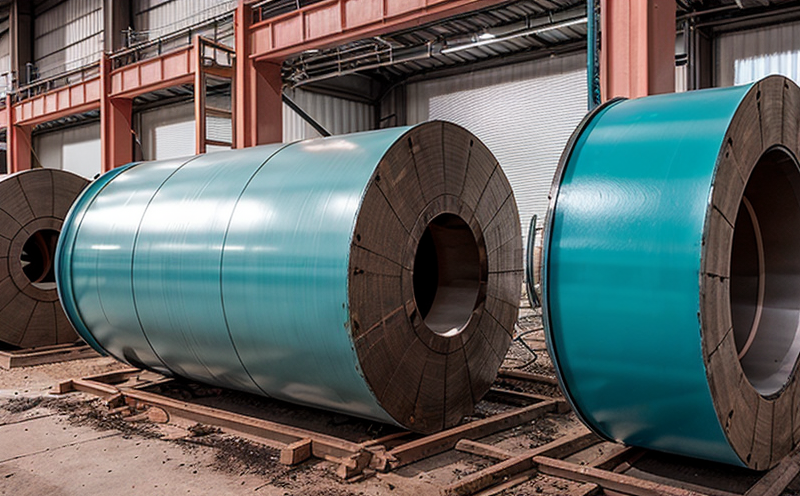EN 13523 Coil Coating Corrosion Testing
The EN 13523 standard is a comprehensive guide for evaluating the corrosion resistance of coil-coated materials used in industrial manufacturing and processing. This test is critical for ensuring that coated products, such as steel sheets, pipes, and other metallic components, can withstand environmental stressors over extended periods without degradation.
The testing method outlined in EN 13523 involves subjecting the coated samples to a simulated corrosive environment designed to mimic real-world conditions. The primary objective is to assess how well the coating resists corrosion under these challenging circumstances. This service plays an essential role in product development, quality assurance, and compliance with industry standards.
The testing process begins with careful preparation of the sample. Specimens are typically cut from the coil material into standard dimensions, ensuring that they represent typical manufacturing applications. The samples undergo various pretreatments to simulate real-world conditions such as acid washing or passivation before applying the coating. Once coated, the specimens are conditioned according to the specified environmental parameters.
The EN 13523 method involves immersion of the coated samples in a salt spray chamber for an extended period. The salt concentration and temperature are carefully controlled to simulate conditions that might be encountered during transportation or storage. After exposure, the samples are thoroughly inspected for signs of corrosion, such as pitting, rusting, or loss of adhesion between the coating and substrate.
The test results are analyzed using standardized criteria defined in EN 13523. These criteria include visual inspection methods, measuring the extent of corrosion, and assessing changes in weight or thickness of the sample over time. The data collected is then reported comprehensively, providing detailed insights into the durability and performance of the coating.
The results of this testing are invaluable for quality managers, compliance officers, R&D engineers, and procurement teams working with industrial manufacturing processes. By ensuring that coatings meet strict corrosion resistance standards, companies can enhance product longevity, reduce maintenance costs, and improve overall reliability in harsh environments.
| Parameter | Description |
|---|---|
| Immersion Duration | Typically 24 hours at a temperature of 35°C ± 1°C and relative humidity above 95% |
| Salt Concentration | 5% NaCl solution by weight in distilled water |
| Inspection Methodology | Visual inspection, measurement of corrosion depth, mass loss analysis |
The testing process is designed to be rigorous and replicable, ensuring consistent results across different laboratories. This consistency is crucial for maintaining quality standards and facilitating international trade in industrial manufacturing sectors.
In conclusion, EN 13523 Coil Coating Corrosion Testing provides a robust framework for evaluating the corrosion resistance of coated materials used in industrial manufacturing processes. By adhering to this standard, companies can ensure that their products meet stringent durability requirements and remain reliable under challenging environmental conditions.
Scope and Methodology
The scope of the EN 13523 Coil Coating Corrosion Testing is broad, encompassing various types of coated materials used in industrial manufacturing. This includes steel coils, galvanized products, painted sheets, and other metallic components that undergo coil coating processes.
Sample Preparation: The first step involves cutting the coil into standard sample sizes to ensure representativeness. These samples are then pretreated as necessary, such as acid washing or passivation, before applying the coating.
Coating Application: After preparation, the samples are coated according to specific technical specifications provided by the client or industry standards.
Conditioning: The coated samples are then conditioned in controlled environments to simulate real-world conditions. This includes temperature and humidity adjustments that mimic storage or transportation scenarios.
Immersion Testing: The samples are immersed in a salt spray chamber for the specified duration, with precise control over temperature, relative humidity, and salt concentration.
Inspection: After exposure, the samples undergo thorough inspection to evaluate any signs of corrosion. This includes visual inspections, measurement of corrosion depth, and mass loss analysis.
The methodology is designed to be standardized and replicable, ensuring consistent results across different laboratories. The use of international standards such as EN 13523 guarantees that the testing process adheres to best practices in the industry.
Why Choose This Test?
Comprehensive Evaluation: The test provides a thorough assessment of the coating's ability to resist corrosion, offering valuable insights into product durability and reliability.
Standard Compliance: By adhering to EN 13523, companies can ensure that their products meet stringent industry standards, facilitating international trade and compliance with regulatory requirements.
Enhanced Quality Assurance: This testing service supports the quality assurance process by identifying potential weaknesses in coatings early on, allowing for necessary adjustments before product release.
Cost-Effective Solutions: By detecting issues during the testing phase, companies can avoid costly repairs and replacements later in the manufacturing or usage lifecycle.
The EN 13523 Coil Coating Corrosion Testing is a critical component of any comprehensive quality assurance program. It provides essential data that helps manufacturers make informed decisions about material selection and process optimization, ultimately leading to higher-quality products and increased customer satisfaction.
Environmental and Sustainability Contributions
Reduction in Waste: By identifying weak coatings early on, this testing helps prevent the production of substandard materials that would otherwise end up as waste.
Emission Control: The use of salt spray chambers ensures that any corrosive emissions are contained and managed properly, reducing environmental impact.
Resource Efficiency: By ensuring coatings meet durability standards, this testing helps reduce the need for frequent replacements, conserving resources over time.
The EN 13523 Coil Coating Corrosion Testing contributes significantly to sustainable manufacturing practices. It supports the development of environmentally friendly products that last longer and require less maintenance, ultimately leading to a more sustainable industrial sector.





